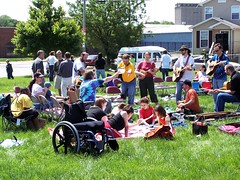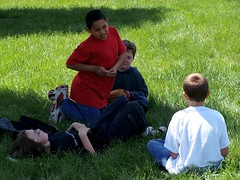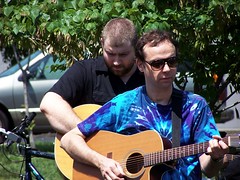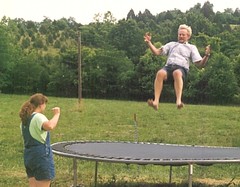The Revelation to John at Patmos, like most examples of apocalyptic writing, is filled with violent imagery. “Apocalypse,” means “unveiling,” and apocalyptic writing "unveils" a global conflict between Good and Evil in cosmic terms, a ‘war to end all wars’ between God and the powers of Light and Satan and the Powers of Evil. Unlike prophetic eschatology, apocalyptic writing seldom mentions judgment on the supposedly righteous community(ies) and doesn’t deal with ambiguity or humility.
For these reasons and others it is hardly surprising that those Christian groups which are most obsessed with studying the details of the Book of Revelation are usually also the most militant: They draw strong lines between the “lost” and the “saved,” and they look forward almost in glee to the way that the forces of evil will “get theirs” when God brings cosmic revenge upon them. Most of these groups also justify Christian participation in military violence.
The best-selling “Left Behind” novels portray Christians (those converted after the pre-millennial “rapture” has removed most of the Church from the scene) forming holy death squads and raids on the enemy. Many sermons from popular TV evangelists from this school are hardly more restrained.
So, it probably isn’t a surprise that Revelation is fairly unpopular in Christian peacemaking circles. Reversing Ernst Käsemann’s dictum (which controlled New Testament scholarship for two generations) that apocalyptic was the underlying substructure that birthed both the New Testament and early Christian theology, some recent researchers into the “historical Jesus” have argued that Jesus was a non-apocalyptic figure who did not expect an imminent end of the world.
Passages such as Mark 13 are seen by these scholars as coming later than Jesus and being read back onto him. (My own view is that Jesus’ eschatology was both prophetic and interacted with the popular apocalypticism of his day, reforming rather than rejecting that genre. But that is an argument for another time.) Sermons in progressive or peace-oriented churches seldom come from Revelation.
This strikes me as understandable-but-mistaken. It allows a very thorough misreading of the Revelation to continue to dominate popular Christian thought. In the Revelation to John, the followers of the Beasts and the Dragon do violence, but the followers of the Lamb do not. Instead, a central theme throughout the book is that the followers of the Lamb do the deeds that Jesus taught (Rev. 2:2, 19, 23, 26; 3:8, 10; 9:20-21; 12:17; 14:4, 12; 16;11; 19:8, 10; 20:4, 12-13; 22:11).
In fact, the Revelation gives Christians clear teaching against doing violence, “Whoever takes the sword to kill, by the sword he is bound to be killed” (Rev. 13:10 NEB, echoing Jesus’ in Matthew 26:52). The verse then gives a call for endurance and faith.
Richard Bauckham, a perceptive student of apocalyptic writing in general and Revelation in particular, observes:
No doubt in the Jewish circles with which John and his churches had contact . . . ideas of eschatological holy war against Rome, such as the Qumran community had entertained and the Zealots espoused, were well known. . . . Therefore, instead of simply repudiating apocalyptic militancy, [John of Patmos] reinterprets it in a Christian sense, taking up its reading of Old Testament prophecy into a specifically Christian reading of the Old Testament. He [John the Revelator] aims to show that the decisive battle in God’s eschatological holy war against evil, including the power of Rome, has already been won--by the faithful witness and sacrificial death of Jesus. Christians are called to participate in his war and his victory--but by the same means as he employed: bearing the witness of Jesus to the point of martyrdom. (Bauckham, The Bible in Politics [Westminster/John Knox Press, 1989], pp.233ff.)G. B. Caird, an Anglican New Testament scholar and pacifist of a generation ago, is also helpful:
Throughout the welter of Old Testament images in the chapters that follow, almost without exception the only title for Christ is the Lamb, and this title is meant to control and interpret all the rest of the symbolism. It is almost as if John were saying to us at one point after another, “Wherever the Old Testament says, ‘Lion,’ read ‘Lamb.’” Wherever the Old Testament speaks of the victory of the Messiah or the overthrow of the enemies of God, we are to remember that the gospel recognizes no other way of achieving these ends than the way of the Cross. (Caird, A Commentary on the Revelation to St. John the Divine [Harper & Row, 1966], pp. 74ff. )But wait, don’t the Christian martyrs in Revelation ask God for vengeance? Yes, in 6:10, they cry out, “Sovereign Lord, holy and true, how long will it be before you judge and avenge our blood on the inhabitants of the earth?” Such feelings are natural even among those committed to nonviolence. But the martyrs are not answered in a way that would encourage continuing their vengeful fantasies (or those of John’s readers who may take up the martyrs’ cry).
They are “each given a white robe [symbolizing innocence] and told to rest a little longer.” They are not given “garments rolled in blood” as warriors. Further, when the Rider on the White Horse (Christ) goes into battle with the “kings of the earth,” he slays them with the “sword of his mouth” which is specifically called the Word of God. (Rev. 19) That is, the only sword with which the risen Christ is armed is the prophetic word of the Good News and he “conquers” by means of evangelism! (U.S. Christians also fail to notice that the “kings of the earth,” the political Powers and Authorities, are arrayed against Christ. There is no description of an exception, a “Christian nation.”)
======
by Michael Westmoreland-White...with more to come!










